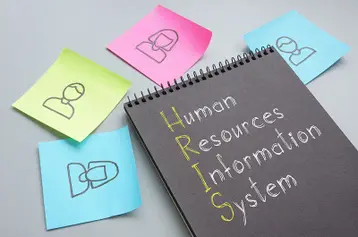
Table of contents
- 1.What is HRIS?
- 2.Benefits of an HRIS
- 3.Improving payroll processes
- 4.Streamlining recruitment and retention
- 5.Enhancing employee engagement and satisfaction
- 6.Helping with compliance requirements
- 7.Facilitating data analysis and decision-making
- 8.Benefits of HRIS for small businesses
- 9.Features of HRIS
- 10.Implementation and adoption of HRIS
- 11.Strategies for successful employee adoption of an HRIS
- 12.Choose the Right HRIS for Your Business
If you're looking for ways to streamline your HR department's processes, the latest software can be an invaluable resource. In this article, we'll take a look at all the ways an HRIS can benefit your business operations and make human resources an efficient process.
What is HRIS?
A human resources information system, or HRIS, is an HR management software package that collects, stores and manages employee data. HR professionals and business managers use this type of human resources management system to help automate standard HR processes, including hiring, payroll, and personnel management.
Typically, an HRIS will store human resources information such as contact details, job titles, and work history. More in-depth HRIS solutions also allow HR professionals to generate reports and analyze company data in real time.
Without a doubt, an HRIS solution is an effective modern business tool. Let's explore the features of HRIS and how they can simplify employee management.
Benefits of an HRIS
HRIS solutions are increasingly common in the business market. Large businesses can greatly profit from a strategic HRIS deployment. But small and medium-size businesses are the best candidates for this type of software, mostly because they're the type of companies that might not have as much flexibility in their hiring and budget.
It's no secret that managing human resources can be costly and complex. A large business might be able to cover all the expenses. But for small and medium-size businesses, the costs can be overwhelming. Here's how some of the best HRIS solutions could help your business and increase profits.
Improving payroll processes
An HRIS automates many core HR processes that are traditionally handled manually. This adds to organizational efficiency, especially if you have a limited team. Tracking employee records and payroll processing have always been labor and time intensive. With the sheer volume of information involved, there's quite a risk of human error. With an HRIS, you can help improve data accuracy, increase efficiency, and decrease labor costs.
Streamlining recruitment and retention
HRIS solutions can help streamline the recruitment process and talent acquisition with automatic applicant tracking, job posting, application processing and background checks. Information you need for interviews can be easily accessed and utilized. A robust applicant tracking system aids HR teams throughout the entire process. Notices, offers, rejections and other items can be auto-sent. All of this can significantly reduce an HR department's load.
Enhancing employee engagement and satisfaction
An HRIS empowers employees to take more control of their careers. Using an employee self-service portal (ESS), staff can:
- Access and update their personal records anytime.
- View their earned benefits.
- Track their leave hours and usage.
- Register for training and development initiatives.
When employees have direct access to information about their role, performance and efficiency, they're more likely to be confident in how they've grown as an employee. Subsequently, they're more likely to experience greater satisfaction in their role.
Helping with compliance requirements
Quality HRIS software can provide a secure, centralized platform for storing and processing sensitive information, preventing data from being misused or inappropriately shared. An HRIS can make it easy to monitor access levels and follow data retention policies. It can also generate reports on any infractions and auto-direct them to managers and administrators. This can help to quickly identify discrepancies and potential departures from compliance requirements. Typically, an HRIS is more than just software. Depending on the platform, you may also gain access to HRIS analysts and experts who can answer your questions and help you troubleshoot.
Facilitating data analysis and decision-making
Data and analytics can be generated with a few simple clicks when using an HRIS. The results provide managers with information for strategic planning and informed decision-making on staffing, training and other initiatives. Data that previously took days to compile can now be accessed instantly and reliably in a report.
Benefits of HRIS for small businesses
TriNet’s HR technology can provide many benefits for small businesses in saving valuable time and energy. Our HRIS can allow an SMB to focus on their core competencies and minimize resource draw required for HR functions. Other benefits include:
- More efficient and focused recruiting efforts with TriNet Hire
- Streamlined onboarding with less opportunity for data-entry and duplication errors
- Actionable Reports & Analytics at your fingertips
- Support for key HR-related compliance concerns
- Convenient on-the-go access for employees and management with TriNet Mobile
- Secure access to HR documents at any time
Features of HRIS
Human resource information systems provide myriad helpful tools and services applicable to businesses large and small across industries. Here's a more detailed look at some of the features and functions of a typical HRIS.
- HRIS software provides employees self-service tools such as vacation planning, leave tracking, paystubs and benefits management. An ESS portal helps prevent regular HR operations from being disrupted by normal day-to-day employee requests.
- Core HR functions are handled by the HRIS rather than costing hours' worth of payroll management by HR teams. Employee data management, payroll management and benefits administration are only some of the many business tasks ripe for automation.
- Talent management runs faster and cleaner under software-based human resources management. Learning and development services are easy to run as a stand-alone portal for all employees. Succession planning can be established and modified quickly.
- Performance management is less prone to negative or prejudicial effects with an HRIS. Employee performance gets tracked in real-time—and weighed against set goals, competencies and reviews. Notices are generated and forwarded to managers as needed.
- Time and attendance management is virtually a hands-off task from a manager's perspective. While at their workstation, employees clock in and out through their personal ESS portals. Absence management is automatic and can be set to notify managers and/or HR. Required daily, weekly or monthly reports get pushed by the HRIS to necessary management personnel.
- Reporting and analytics come easy with automatic report generation. Management dashboards in an HRIS offer fast insights into employee performance, trends and costs. Reports that previously took entire HR teams hours to create now happen in seconds. And quick, valid data is paramount when a budget planning or cost review meeting pops up.
- Integration with other systems helps streamline employee and HR needs. Save time and effort by integrating health insurance, retirement plans and payroll tax documentation into an HRIS. Onboard new hires faster and better with pre-programed employee education courses and materials.
Implementation and adoption of HRIS
When implementing a new HRIS, there are some basic steps to consider with deployment:
- Assess the business needs in order to determine the best-suited HRIS. Consider key features, functionality, options and scalability, as well as the different types of HRIS systems available.
- Select from HRIS vendors who meet the needs, budgeting and timeline for your current HR processes. Ask about if and how their product and services will adapt and scale with you as your needs change.
- Work with a vendor to design the system and set up user accounts.
- Do a full system test well before a live deployment. Make sure everything functions as expected.
- Train employees on the new system and how ESS portals work and explain any data entry nuances.
- Monitor the system performance and make necessary adjustments as needed. A records and employee database may grow rapidly. Ensure the computing hardware supports future storage and processing needs before the existing system bogs down or errs.
- Evaluate the effectiveness of the system. Ensure that it meets all the business's needs—and if not, modify the system as needed.
Strategies for successful employee adoption of an HRIS
Here are considerations to how employees can best take advantage of an HRIS:
- Fully explain the HRIS to employees. What does it do and how will it be used? Make sure everyone understands the value of the new system and how it helps both management and employees.
- Provide adequate training so employees understand how to use the system. Training is best when tailored to a user's specific roles and needs.
- While the system is implemented, solicit employee feedback to ensure the HRIS is meeting the needs of all users.
- Consider incentives like celebrating implementation milestones to encourage employee motivation and satisfaction.
- Ensure the HRIS is as easy to use as possible. Aim for an intuitive interface with simple navigation and clear guidance.
- Monitor usage to identify problem areas where users struggle with the system. If needed, adjust the system, modify portals and provide additional training.
Choose the Right HRIS for Your Business
What is an HRIS? One of the most important tools available for businesses today. An HRIS can help you manage employee data, track labor costs, and improve employee engagement and satisfaction. These sophisticated software suites are becoming increasingly popular as businesses seek more efficient ways to employ workforce management.
HRIS trends favor cloud-based systems, analytics integration and mobile-friendliness. Are you ready for your HR processes to experience a digital transformation and efficiency overhaul?
TriNet provides HRIS solutions and HR outsourcing for businesses with five to 1,000 employees, empowering them to focus on what matters. Learn how organizations benefit from TriNet's human capital management expertise, access to benefits, risk mitigation, compliance, payroll, real-time technology and more.
This communication is for informational purposes only; it is not legal, tax or accounting advice; and is not an offer to sell, buy or procure insurance.

TriNet Team
Table of contents
- 1.What is HRIS?
- 2.Benefits of an HRIS
- 3.Improving payroll processes
- 4.Streamlining recruitment and retention
- 5.Enhancing employee engagement and satisfaction
- 6.Helping with compliance requirements
- 7.Facilitating data analysis and decision-making
- 8.Benefits of HRIS for small businesses
- 9.Features of HRIS
- 10.Implementation and adoption of HRIS
- 11.Strategies for successful employee adoption of an HRIS
- 12.Choose the Right HRIS for Your Business






